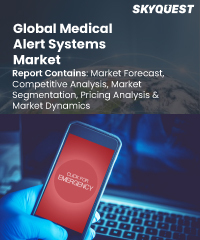
Product ID: SQMIG35A2279

Report ID:
SQMIG35A2279 |
Region:
Global |
Published Date: March, 2024
Pages:
219
|
Tables:
59 |
Figures:
75
Drivers
Increasing emphasis on aging in place
Restraints
High cost associated with these systems
Our industry expert will work with you to provide you with customized data in a short amount of time.
REQUEST FREE CUSTOMIZATIONMedical Alert Systems Market size was valued at USD 6.94 billion in 2021 and is poised to grow from USD 7.15 billion in 2022 to USD 14.66 billion by 2030, growing at a CAGR of 10.8% during the forecast period (2023-2030).
The medical alert systems market is characterized by a mix of established companies and emerging players. The market is highly competitive, driven by constant innovation and technological advancements. Key factors influencing competition include product offerings, pricing strategies, distribution networks, and brand recognition. Companies are focusing on expanding their product portfolios, enhancing user experience, and developing integrated solutions to gain a competitive edge. Additionally, strategic collaborations, partnerships, and acquisitions are prevalent in the market as companies strive to strengthen their market presence and cater to the evolving needs of the aging population. 'Philips Lifeline (US)', 'Alert1 (US)', 'ADT Corporation (US)', 'Tunstall Healthcare (UK)', 'Medical Guardian (US)', 'Bay Alarm Medical (US)', 'LifeFone (US)', 'MobileHelp (US)', 'Life Alert Emergency Response (US)', 'Guardian Alarm (US)', 'AlertOne Services (US)', 'Galaxy Medical Alert Systems (US)', 'LifeStation (US)', 'Rescue Alert (US)', 'Connect America Medical Alert Systems (US)', 'LifeCall (US)', 'LogicMark (US)', 'Tunstall Americas (US)', 'VRI (US)', 'Aloe Care Health (US)'
One significant driver in the medical alert systems market is the increasing emphasis on aging in place. With a growing elderly population and a preference for staying in the comfort of their homes, there is a rising demand for medical alert systems that enable older adults to receive prompt assistance in case of emergencies. The ability to age in place promotes independence and enhances the overall quality of life for the elderly. As a result, the market for medical alert systems is experiencing substantial growth as more individuals seek solutions that facilitate safe and secure aging in their own residences.
One key trend in the medical alert systems market is the integration of advanced technologies such as artificial intelligence (AI) and Internet of Things (IoT) capabilities. These technologies enable enhanced monitoring, remote patient management, and real-time data analysis. AI-powered algorithms can detect patterns and anomalies, providing proactive alerts and personalized care for individuals using medical alert systems. IoT integration allows for seamless connectivity between devices and platforms, facilitating effective communication and information exchange. This trend towards technological integration is revolutionizing the medical alert systems industry, offering more efficient and comprehensive solutions for elderly care.
North America dominated the medical alert systems market. The region has a well-established healthcare infrastructure and a high adoption rate of advanced technologies. The United States, in particular, has a large aging population and a growing awareness of the benefits of medical alert systems. Moreover, the presence of key market players and continuous advancements in healthcare contribute to the dominance of North America in the market.
Want to customize this report? This report can be personalized according to your needs. Our analysts and industry experts will work directly with you to understand your requirements and provide you with customized data in a short amount of time. We offer $1000 worth of FREE customization at the time of purchase.

Product ID: SQMIG35A2279